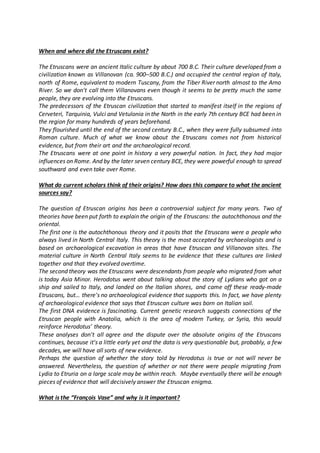
The etruscan
- 1. When and where did the Etruscans exist? The Etruscans were an ancient Italic culture by about 700 B.C. Their culture developed from a civilization known as Villanovan (ca. 900–500 B.C.) and occupied the central region of Italy, north of Rome, equivalent to modern Tuscany, from the Tiber River north almost to the Arno River. So we don't call them Villanovans even though it seems to be pretty much the same people, they are evolving into the Etruscans. The predecessors of the Etruscan civilization that started to manifest itself in the regions of Cerveteri, Tarquinia, Vulci and Vetulonia in the North in the early 7th century BCE had been in the region for many hundreds of years beforehand. They flourished until the end of the second century B.C., when they were fully subsumed into Roman culture. Much of what we know about the Etruscans comes not from historical evidence, but from their art and the archaeological record. The Etruscans were at one point in history a very powerful nation. In fact, they had major influences on Rome. And by the later seven century BCE, they were powerful enough to spread southward and even take over Rome. What do current scholars think of their origins? How does this compare to what the ancient sources say? The question of Etruscan origins has been a controversial subject for many years. Two of theories have been put forth to explain the origin of the Etruscans: the autochthonous and the oriental. The first one is the autochthonous theory and it posits that the Etruscans were a people who always lived in North Central Italy. This theory is the most accepted by archaeologists and is based on archaeological excavation in areas that have Etruscan and Villanovan sites. The material culture in North Central Italy seems to be evidence that these cultures are linked together and that they evolved overtime. The second theory was the Etruscans were descendants from people who migrated from what is today Asia Minor. Herodotus went about talking about the story of Lydians who got on a ship and sailed to Italy, and landed on the Italian shores, and came off these ready-made Etruscans, but… there's no archaeological evidence that supports this. In fact, we have plenty of archaeological evidence that says that Etruscan culture was born on Italian soil. The first DNA evidence is fascinating. Current genetic research suggests connections of the Etruscan people with Anatolia, which is the area of modern Turkey, or Syria, this would reinforce Herodotus’ theory. These analyses don't all agree and the dispute over the absolute origins of the Etruscans continues, because it's a little early yet and the data is very questionable but, probably, a few decades, we will have all sorts of new evidence. Perhaps the question of whether the story told by Herodotus is true or not will never be answered. Nevertheless, the question of whether or not there were people migrating from Lydia to Etruria on a large scale may be within reach. Maybe eventually there will be enough pieces of evidence that will decisively answer the Etruscan enigma. What is the “François Vase” and why is it important?
- 2. The Francois vase is one of the largest symposium vase made in Athens. It is painted and potted by two men of whose we know the names: Ergotimos the potter and Kleitias the painter. And it has 270 figures of the Greek mythology painted on it. And 130 Greek inscriptions by which they also taught the Etruscans some words and some mythology. The main frieze of the vase, the most important one, it is the only one who goes all around the vase while the rest of the myths are represented one on one side and one on this side. It is the wedding procession for Peleus and Thetis marriage, Achilles' parents. This is the place where the potter and the painter have signed the vase. It is popularly called the “Holy Bible” of mythology, because it has several myths painted on it, related to the figure of Achilles, Theseus and mainly the wedding pompe, the wedding procession for Peleus and Thetis, Achilles' parents. That was a very important mythological subject for the first half of the 6th century BC because we had it painted on a few large vases made in Athens and sent to Etruria.
